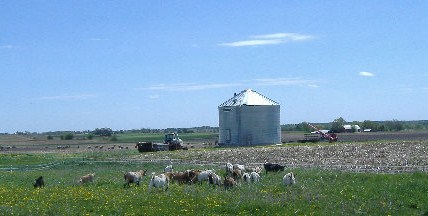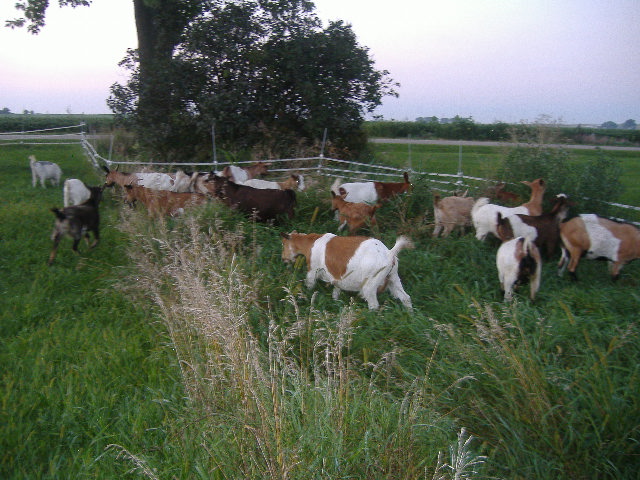DOE CARE:
Does are not hard to care for. They need a separate pen from the bucks when they are not breeding so you don't have doe kids being bred too young or to their father.
Vaccines/Dewormers:
Does should be yearly vaccinated with a CD/T vaccine, ether the Bar Vac, or the Covexin 8 product which covers more. I normally vaccinate the does two weeks right before kidding to make sure they pass it on to their kids. Also, I vaccinate my does with Lepto-5. Before breeding, if you live in a selenium deficient area, give 1/2cc of Bo-Se a week before kidding. Ask your vet if your area is selenium deficient, because too much is as harmful as too little. Deworm with Dectomax cattle dewormer as needed, 1cc per #50 pounds, do fecals to find which worms are the most common on your farm, and don't deworm unless needed, this just makes the worms become more resistant to the dewormer faster. Does can also be dewormed with Valbazen dewormer right after kidding or when not pregnant, do not use if they have been bred since it can cause abortions, follow directions on bottle.

Hoof Trimming:
A doe's hooves should be trimmed regularly, since each goat is different, and the hooves grow slower/faster then others, you should check each goat monthly to find which ones need it. It is easier to keep the hooves trimmed then to let them go, the doe can become lame, or get hairy warts and hoof rot. During the last two-three months of pregnancy, it is better not to trim as the doe may struggle and abort the kids, unless they are very bad. You can generally still do the front feet. Then trim a day or two after kidding (to give her a rest).
Companionship:
A doe should have another doe or wether as a buddy to keep her company and prevent boredom. While does will fight, they normally do not fight as much as bucks as long as they have enough space, but you can get some very bossy does who push other does around. It's best to have all dehorned/polled does, you don't have to worry about them ramming each other and causing abortions or flipping kids over their back with their horns or breaking legs or getting stuck in a fence/hole somewhere.
Feed:
Good, grassy hay with a little alfalfa is best for doe, you don't want them to get too fat or they may develop reproductive problems. Does need grain while pregnant and nursing, you can get goat mixes from most Co-ops, just make sure it has copper, if it doesn't, it's most likely a sheep feed. Purina makes several goat feeds, so you can find one from them. A goat mineral block is important as well to ensure the bucks/wethers get enough minerals and vitamins. I use the 37% protein range block from Fleet Farm that is for cattle & goats, it contains the copper goats need along with the loose cattle mineral that comes in a red & white bag. Always have loose mineral with copper and the protein blocks out for them. Always have fresh, clean water, promptly clean any tank/bucket that gets feed/dirt/algae because all goats are picky and will not drink dirty water. In the winter a heated bucket or tank is your best bet, you won't have to worry about the water freezing and having to haul hot water to thaw it. Make sure any cords are out of reach and the bucket/tank can't be tipped over. I found during the warm months that a $30 drinking cup that connects to a hose provides fresh water 24/7 and you don't have to worry about kids falling into the tank.
Fencing:
Cattle panels have worked the best for me for doe, not only are they near impossible for them to get out; they also can't beat up the fence with their horns, and are more reluctant to beat on metal T-posts. Depending on how many does will be in the pen will determine the size of the pasture. The more does in the pen, the bigger it needs to be to prevent fighting for space. I also found that 1" poly tape works great as well, just make sure you have at least three stands with the top strand being knee high (remember we are talking about fainters here!) and a good strong fence charger. Goats will not respect a weak fence charger, so you need to make sure to get one that will give a good zap. At my old place those three strands held the does in just fine because of a appropriate

Housing:
The does should have a sturdy, draft-free shed or hut to get out of the snow and rain. A shed is better deeper then wide if there is no door, helps keep the rain/snow from blowing too far in and getting the does wet and miserable. Bed it light during the summer, and heavy in the winter with ether pine shavings or straw, do not use cedar shavings, they contain chemicals that can make the goats sick! Along with a shed, have some other areas of shade, ether natural or man made, to prevent them from becoming too warm in the hot summer sun. Pig huts or calf hutches are good as well during the summer since they allow more air through and give the kids places to hide and sleep.
Play:
Does like to play, although not as much as bucks, but they still like mounds of dirt to lie on, or rocks to play on. Stumps or logs make great head scratchers.
Signs of heat:
A doe in heat will indicate her breeding interest by wagging her tail rapidly for the buck ("flagging"). Her urine contains pheromones which tell the buck that she is ready to breed.
A doe's heat cycle is approximately every 18-21 days.
Signs of heat: (A doe may exhibit any, all, or none of these signs)
* "Flagging" (wagging) her tail.
* Mounting other does.
* Letting other does mount her.
* Fighting
* Letting herself get beat up without defending herself.
* Having a "crush" on another doe.
* No interest in feed.
* Swollen and/or pink rear end.
* Mucous discharge from her vagina
* Tail hair is wet and/or clumped together.
* Baaing for no reason.
A doe's heat lasts anywhere from 6 hours to 3
days depending on the doe. A doe should not be bred until she is at least 11-12 months old and in good shape, not too skinny and not too fat which will cause problems while pregnant and kidding. If you suspect a doeling has been bred too early (doelings can breed as early as two months old), you can get a drug called Lutalyze from your vet which when given in a 2cc dose (no matter size or age) will cause the doe to abort in 18 hours, give the shot 7 days after you suspect breeding. This will bring the doe back into heat so make sure she is not around any bucks or bucklings! Please do not allow your goats to be bred sooner then 11-12 months, it's not good on the doe and chances are you'll lose the kid, the doe, or she will reject the kid because she is too young mentally. Plus her growth can be stunted as well since she is trying to give energy to both her kids and herself at the same time. If she is old enough and you put her with a buck, you can tell a successful breeding because the buck will do a forward "hop" when he ejaculates. Make sure you write down the breeding date so you know when to expect kids. If she does not return to heat in 18-21 days, chances are good she is bred. If you have a doe who comes into heat every week, or has silent or weak heats (make sure she isn't bred and you just didn't catch it), you can give 1/2cc of GnRH (vet) to her. That will help normalize the heat cycle. It will not cause abortions so if you give it to a pregnant doe she will be fine.
Gestation Period:
The gestation period is the time from conception to kidding. Normally this is roughly 145-155 days, or 5 months. However does can go a week early or a week later and be fine. It is best to make sure no kids are nursing on the doe for at least 2 months before kidding (remove kids if the doe does not wean on her own, most fainters do wean their kids, also make sure there is no buck kids in with the does past two months because they CAN AND WILL breed their dams and sisters!).